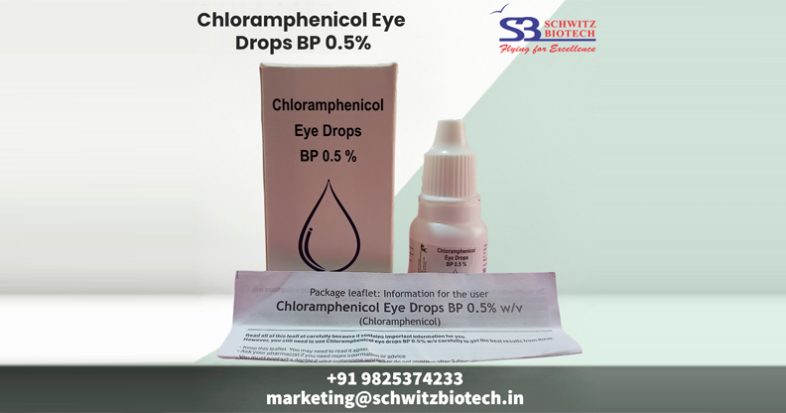CHLORAMPHENICOL EYE DROPS

CHLORAMPHENICOL EYE DROPS BP 0.5% W/V (CHLORAMPHENICOL)
Read all of this leaflet carefully because it contains important information for you. However, you still need to use Chloramphenicol eye drops BP 0.5% w/vcarefully to get the best results from them.
- Keep this leaflet. You may need to read it again.
- Ask your pharmacist if you need more informationor advice
- You must contact a doctor if your symptoms worsenor do not improve after 2 days
- If any of the side effects gets serious, or if younotice any side effects not listed in this leaflet,please tell your doctor or pharmacist.
WHAT IS IN THIS LEAFLET
- What Chloramphenicol is and what it is used for
- What you need to know before you use Chloramphenicol
- How to use Chloramphenicol
- Possible side effects
- How to store Chloramphenicol
- Contents of the pack and other information
WHAT CHLORAMPHENICOL IS AND WHAT IT IS USED FOR
Chloramphenicol belongs to a group of medicine called antibiotics. Chloramphenicol is used in both adults and children to treat bacterial conjunctivitis, which is an infection of the outer surfaces of the eye. The infected eye will probably be red, gritty or itchy. In the morning there will be a sticky discharge which may make it difficult to open the eye. When put in the eye, chloramphenicol works by helping kill the bacteria (germs) and allow the body to overcome the infection.
WHAT YOU NEED TO KNOW BEFORE YOU USE CHLORAMPHENICOL DO NOT USE CHLORAMPHENICOL
- If you are allergic (hypersensitive) to chloramphenicol or to any other ingredients of this medicine (see section 6 for more details)
- If you or someone in your family ever had a blood disorder or bone marrow disease including anemia (decrease in the number of red blood cells) when using chloramphenicol in the past.
- If you have a family history of “dyscrasias”, a condition which can cause tiredness, bruising and an increased risk of infections Take special care
- If you develop a new eye infection during this treatment, you should stop using the drops and speak to your doctor.
- If you use chloramphenicol eye drops for a long time, your doctor may do some blood tests to check for any problems.
WARNINGS AND PRECAUTIONS TALK TO YOUR DOCTOR OR PHARMACIST BEFORE USING CHLORAMPHENICOL
- if you have visual disturbances
- if you have severe pain in the eye
- if you are sensitive to light
- if your eye is inflamed and you have a rash on the scalp or face
- if your eye looks cloudy
- if your black or coloured part of the eye looks unusual
- if you have a foreign body in the eye
- if you have an eye infection that keeps coming back
- if you have glaucoma (raised pressure in the eye)
- if you have dry eyes
- if you have eye injury or eye surgery
- if you are currently using any other eye drops or eye ointment
Other medicines and chloramphenicol Tell your doctor or pharmacist if you are taking, have recently taken or might take any other medicines, including using eye drops or eye ointment and medicines obtained without a prescription before you start to use this medicine. Your medicine may affect their action and could alter their effect.
IN PARTICULAR, TELL YOUR DOCTOR IF YOU ARE TAKING ANY OF THE FOLLOWING
- medicines for cancer such as methotrexate
- medicines for the immune system such as azathioprine
PREGNANCY AND BREAST-FEEDING
- Chloramphenicol should not be used during pregnancy and breast-feeding unless considered essential by your doctor, as the effects are unknown.
- If you are pregnant or breast-feeding, think you may be pregnant or are planning to have a baby, ask your doctor or pharmacist for advice before using this medicine.
DRIVING AND USING MACHINES
No effects on ability to drive and use machines have been reported. However do not drive or operate machines if you experience any visual disturbance after using the product. Wait until this clears before driving or using machines.
CHLORAMPHENICOL CONTAINS PHENYL MERCURIC NITRATE
Chloramphenicol eye drops contain phenylmercuric nitrate as a preservative which may cause allergic reaction. Do not wear contact lenses during treatment. Wait until 24 hours after the end of the treatment before you wear your Contact lenses. You can wear glasses during treatment.
HOW TO USE CHLORAMPHENICOL
- Always use Chloramphenicol exactly as your doctor has told you. Check with your doctor or pharmacist if you are not sure.
- The recommended dose is two drops applied to the affected eye(s) every three hours. Use during waking hours only. Continue treatment at least 48 hours after the eye appears normal, or as directed by your doctor.
USE IN CHILDREN
Dosage adjustment may be necessary in newborn infants because of reduced systemic elimination due to immature metabolism and the risk of dose – related adverse effect. The maximum duration of treatment is 10-14 days If you are using in combination with another eye drop medicine, wait 5-15 minutes before applying the second eye drop.
INSTRUCTIONS FOR USE : (PLEASE ALSO REFER TO PICTOGRAMS AT THE END OF THE LEAFLET)
- First wash your hands
- Avoid touching the eye (or any other surface) with the tip of the bottle
- These drops are supplied as a sealed bottle with a spiked cap. When using the bottle for the first time, screw the cap down tightly in order to pierce the tip of the bottle
- Tilt your head back and look at the ceiling
- Pull the lower eyelid gently downwards
- Hold the bottle upside down above the eye and gently squeeze the bottle to release a drop into your eye
- Keep the affected eye closed and press your fingertip against the inside corner of the closed eye, and hold for 1 minute
- Repeat for the other eye if necessary
- Replace and tighten the cap immediately after use.
Be careful not to touch the tip of the bottle on your eye or on any other surface. Ocular solutions, if handled wrongly, can become contaminated by common bacteria and cause eye infections. If you do develop any other eye condition whilst using this product, see your doctor immediately.
IF YOU USE MORE CHLORAMPHENICOL THAN YOU SHOULD
If you accidently apply too much drops, you should wash your eye with plenty of water, if any painful symptoms continue after this, you should tell your doctor immediately.
IF YOU FORGET TO USE CHLORAMPHENICOL
Apply the drops as soon as you remember. However, if it is almost time for your next dose, do not double your dose and carry on with the normal schedule dose.
IF YOU STOP USING CHLORAMPHENICOL
To be effective chloramphenicol must be used every day. Do not stop using chloramphnicol until your doctor tells you so. If you have any further questions on the use of this medicine, ask your doctor or pharmacist.
POSSIBLE SIDE EFFECTS
Like all medicines, Chloramphenicol can cause side effects, although not everybody gets them. Some people find that their eyes sting or their sight is blurred immediately after using the drops. These effects should wear off after a short time. If prolonged irritation, swelling, watery eyes or sensitivity to light occurs, then exposed eye should be washed with water for 15 minutes. If the symptoms continue after this, an eye examination may be required. Stop using your medicine and tell your doctor or pharmacist immediately if you experience the following side effects:
- Wheeziness (shortness of breath), fever, swelling of your face, lips or tongue, itching or rash with swelling of skin (the rash could be puffy (swollen) or blotchy, or look like little blisters.
- A sore throat, bruising or being unable to overcome an infection. On very rare occasions, patients using chloramphenicol have had changes in their blood cells causing severe tiredness or easy bruising.
- If any of the side effects gets serious, or if you notice any side effects not listed in this leaflet, please tell your doctor or pharmacist.
REPORTING OF SIDE EFFECTS
If you get any side effects, talk to your doctor or pharmacist. This includes any possible side effects not listed in this leaflet. By reporting side effects you can help provide more information on the safety of this medicine.
HOW TO STORE CHLORAMPHENICOL
- Keep this medicine out of the sight and reach of children.
- Store in a refrigerator at a temperature between 2°C and 8°C.
- Protect from light.
- Discard the bottle 28 days after opening, even if there is solution remaining.
- Do not use Chloramphenicol after the expiry date which is stated on the carton and label after ‘EXP’. The expiry date refers to the last day of that month.
- Do not throw away any medicines via wastewater or household waste. Ask your pharmacist how to throw away medicines you no longer use. These measures will help protect the environment.
CONTENTS OF PACK AND OTHER INFORMATION WHAT CHLORAMPHENICOL CONTAINS
- The active substance is chloramphenicol 0.5% w/v.
- The other ingredients are borax, boric acid, phenyl mercuric nitrate (as preservative) 0.002% w/v and water for injection.

